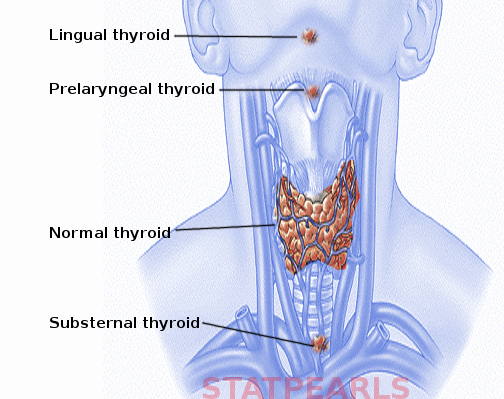[1]
Johansson E,Andersson L,Örnros J,Carlsson T,Ingeson-Carlsson C,Liang S,Dahlberg J,Jansson S,Parrillo L,Zoppoli P,Barila GO,Altschuler DL,Padula D,Lickert H,Fagman H,Nilsson M, Revising the embryonic origin of thyroid C cells in mice and humans. Development (Cambridge, England). 2015 Oct 15;
[PubMed PMID: 26395490]
[2]
Siddique M,Bashir H, 99mTc Sodium Pertechnetate Uptake in Ectopic Mediastinal Thyroid Tissue on Hybrid Thyroid Scintigraphy. Clinical nuclear medicine. 2018 Nov;
[PubMed PMID: 30015662]
[3]
Kumar Choudhury B,Kaimal Saikia U,Sarma D,Saikia M,Dutta Choudhury S,Barua S,Dewri S, Dual ectopic thyroid with normally located thyroid: a case report. Journal of thyroid research. 2011;
[PubMed PMID: 21765986]
Level 3 (low-level) evidence
[4]
Ibrahim NA,Fadeyibi IO, Ectopic thyroid: etiology, pathology and management. Hormones (Athens, Greece). 2011 Oct-Dec;
[PubMed PMID: 22281882]
[5]
Nettore IC,Cacace V,De Fusco C,Colao A,Macchia PE, The molecular causes of thyroid dysgenesis: a systematic review. Journal of endocrinological investigation. 2013 Sep;
[PubMed PMID: 23698639]
Level 1 (high-level) evidence
[6]
Abu-Khudir R,Paquette J,Lefort A,Libert F,Chanoine JP,Vassart G,Deladoëy J, Transcriptome, methylome and genomic variations analysis of ectopic thyroid glands. PloS one. 2010 Oct 15;
[PubMed PMID: 20976176]
[7]
Kim MS,Kong YH,Lee DY, A Case of Subclinical Hypothyroidism with Lingual and Right Pretracheal Ectopic Thyroid. Journal of clinical research in pediatric endocrinology. 2015 Jun;
[PubMed PMID: 26316439]
Level 3 (low-level) evidence
[8]
Fisher DA,Klein AH, Thyroid development and disorders of thyroid function in the newborn. The New England journal of medicine. 1981 Mar 19;
[PubMed PMID: 6258072]
[9]
Passah A,Arora S,Damle NA,Sharma R, Triple Ectopic Thyroid on Pertechnetate Scintigraphy. Indian journal of endocrinology and metabolism. 2018 Sep-Oct;
[PubMed PMID: 30294586]
[10]
Matta-Coelho C,Donato S,Carvalho M,Vilar H, Dual ectopic thyroid gland. BMJ case reports. 2018 Oct 2;
[PubMed PMID: 30279251]
Level 3 (low-level) evidence
[11]
Amani Mel A,Benabadji N,Benzian Z,Amani S, Ectopic lingual thyroid. Indian journal of nuclear medicine : IJNM : the official journal of the Society of Nuclear Medicine, India. 2012 Apr;
[PubMed PMID: 23723588]
[12]
Singhal P,Sharma KR,Singhal A, Lingual thyroid in children. Journal of the Indian Society of Pedodontics and Preventive Dentistry. 2011 Jul-Sep;
[PubMed PMID: 21985888]
[13]
Abdallah-Matta MP,Dubarry PH,Pessey JJ,Caron P, Lingual thyroid and hyperthyroidism: a new case and review of the literature. Journal of endocrinological investigation. 2002 Mar;
[PubMed PMID: 11936471]
Level 3 (low-level) evidence
[14]
Jaruratanasirikul S,Piriyaphan J,Saengkaew T,Janjindamai W,Sriplung H, The etiologies and incidences of congenital hypothyroidism before and after neonatal TSH screening program implementation: a study in southern Thailand. Journal of pediatric endocrinology
[PubMed PMID: 29750647]
[15]
Elprana D,Manni JJ,Smals AG, Lingual thyroid. Case report and review of the literature. ORL; journal for oto-rhino-laryngology and its related specialties. 1984;
[PubMed PMID: 6728436]
Level 3 (low-level) evidence
[16]
Agrawal P,Philip R,Saran S,Gutch M,Razi MS,Agroiya P,Gupta K, Congenital hypothyroidism. Indian journal of endocrinology and metabolism. 2015 Mar-Apr;
[PubMed PMID: 25729683]
[17]
Swaby R, Lingual thyroid: ectopic gland in the tongue base. Archives of disease in childhood. 2019 Jan 17;
[PubMed PMID: 30655262]
[18]
Touati G,Léger J,Toublanc JE,Farriaux JP,Stuckens C,Ponte C,David M,Rochiccioli P,Porquet D,Czernichow P, A thyroxine dosage of 8 micrograms/kg per day is appropriate for the initial treatment of the majority of infants with congenital hypothyroidism. European journal of pediatrics. 1997 Feb;
[PubMed PMID: 9039509]
[19]
Turri-Zanoni M,Battaglia P,Castelnuovo P, Thyroglossal Duct Cyst at the Base of Tongue: The Emerging Role of Transoral Endoscopic-Assisted Surgery. The Journal of craniofacial surgery. 2018 Mar;
[PubMed PMID: 29023300]
[20]
Naik K, Redefining anatomy in a case of midline subhyoid ectopic thyroid. The Indian journal of surgery. 2014 Aug;
[PubMed PMID: 25278663]
Level 3 (low-level) evidence
[21]
Jakibchuk K,Ali S,Samantray J, Recurrence of Graves' disease in ectopic thyroid tissue. BMJ case reports. 2018 Jan 23;
[PubMed PMID: 29367360]
Level 3 (low-level) evidence
[22]
Sturniolo G,Vermiglio F,Moleti M, Thyroid cancer in lingual thyroid and thyroglossal duct cyst. Endocrinologia, diabetes y nutricion. 2017 Jan;
[PubMed PMID: 27825535]
[23]
Lianos G,Bali C,Tatsis V,Anastasiadi Z,Lianou E,Papathanasiou V,Messinis T, Ectopic thyroid carcinoma. Case report. Il Giornale di chirurgia. 2013 Apr;
[PubMed PMID: 23660162]
Level 3 (low-level) evidence
[24]
Leung AKC,Leung AAC, Evaluation and management of the child with hypothyroidism. World journal of pediatrics : WJP. 2019 Feb 8
[PubMed PMID: 30734891]

